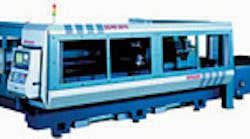At Janco Industries in Sully, Iowa, Joel Jansen had a thriving business, making various structures in mild and some stainless steel for the agricultural, food processing, foodservice and construction industries. But a 2004 visit to the International Machine Tools Show (IMTS) in Chicago changed his view on his company and its future. What Jansen saw there was the ECHO III flying optic laser system demonstrated by Han Kwang USA, the U.S. subsidiary of the widely known builder of laser cutting equipment.
Jansen had looked into laser cutting in the past, but the ECHO III had some noticeable differences from other units available. The Panasonic resonator, which generates the laser beam, had significant upsides in running and maintenance costs. In addition to the precision flying optics design, it could make more complex metal parts with holes and cutouts in less time with its twin linear drive motor system. The shuttle table system ran at 1,200 IPM, for enhanced loading and unloading of the workpieces, a real time-saver.
What sealed the deal for Jansen, however, was the Siemens SINUMERIK 840D CNC, with a user-friendly design for PC interface, substantial 10 GB hard drive, 2 MB memory, and a network-based, remote diagnostic support that Jansen cites as an essential element in his decision to buy the Han Kwang system. Training would be critical and local support was essential. Han Kwang and Siemens had offices and training facilities in Chicago, so the decision became easier.
All these factors combined with a small footprint, fast positioning speed, auto-focus-control for varying the beam target with high precision and, as Jansen observes, “a price that left the other players in the dust,” to solidify his purchase.
The advantage of the flying optic laser design are several. The optics move in the X and Y axes, so the material remains stationary. Owing to the high precision of dual Siemens linear motor drives, the positioning is fast — 170m/min or 6693 in/min, with 0.004 in. accuracy — and the acceleration is substantial — 10m/s sec2 or 393 in./sec2) with constant inertial dynamics, and therefore minimal wear on the rack-and-pinion assembly.
The CNC controls all the laser power settings, as well as axis movement and feed rates. With DNC and LAN interface, the remote diagnostic capabilities allow Janco operators to interact quickly with production control or even Siemens personnel, over the Internet, for assistance and direct real-time troubleshooting.
Janco Industries uses laser to produce structures and components for its ag, construction and food processing equipment customers, working in various mild and stainless steel plate.
DC turbo resonator generates 4-kW power output.
Janco’s Han Kwang’s Echo III laser handles workpieces up to 800 kg (1,760 lbs.), and offers auto-focus control with 9.5 mm (0.375 in.) max. focal length variation, achieved through air pressure deformation of a hardgold-coated mirror. In this 4-kW unit, material thicknesses over a wide range can be cut, ideal for a job shop such as Janco. Mild steels from 1-20 mm (0.04-0.94 in.) and stainless from 0.8-12 mm (0.03-0.47 in.) are routinely processed at Janco to fabricate the various components the shop produces for its diverse customer base.
When programming the laser, Janco uses its own software as well as the onboard ProDesign program, which automates the programming of sheetmetal cutting machines from CAD to the critical nesting function that directly impacts material consumption and a shop’s profitability, according to Joel Jansen. Additionally, because the program allows various lead-in/lead-out settings for differing contours, more diverse parts can run simultaneously, another cost-saving feature.
Also, software updates can be made by direct uploading from the manufacturer, thus keeping Janco equipped with the latest versions of all applicable programs.
Joel Jansen of Janco Industries, Eric Kim of Han Kwang USA and Sean Kim of Siemens Machine Tool Business contributed to this report.










